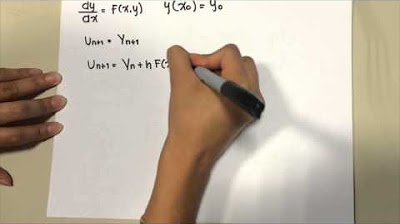Solved Example | Finite Element Method | Part#1
Summary
TLDRIn this educational video from E Academy, the presenter, DA, delves into solving a differential equation using the finite element method (FEM). The video focuses on a specific case where the differential equation involves a force function of -x squared. The domain is from 0 to 1, with both ends fixed, indicating no displacement. The objective is to find the displacement vectors across five nodes, divided into four linear elements, each of length 0.25. The video outlines the process of calculating the stiffness matrix for each element, highlighting the importance of the element's length and the shape functions in the local coordinate system. The summary sets the stage for the next video, which will address finding the force vector and its integration into the global system.
Takeaways
- 📚 The video is a tutorial on solving a differential equation using the finite element method, focusing on the application of general steps previously discussed.
- 🔍 The differential equation in question is a special case with 'a' specified as -1 and the force 'f' as -x^2, contrasting with the general form.
- 📐 The domain for the problem is from 0 to 1, with both boundary conditions set to zero, indicating no displacement at either end of the domain.
- 🛠 The target is to find the displacement vectors 'u' for an unspecified number of elements in the bar, which is later clarified to be four linear elements.
- 🔑 The bar is divided into four linear elements, and the displacement at each node needs to be determined.
- 📏 Each element's length is crucial for constructing the stiffness matrix, with each element having a length of 0.25 units.
- 📝 The script outlines the general structure for the stiffness matrix at the element level, using shape functions and local coordinates.
- 🔄 The stiffness matrix for each element is the same due to identical element lengths and material properties, allowing for a symmetric approach.
- 📉 The shape functions, crucial for the stiffness matrix, are derived from the shear function and involve taking derivatives to integrate.
- 🔍 The script mentions that the force vector will be discussed in a subsequent video, indicating a continuation of the tutorial series.
- 📺 The video concludes with an invitation to subscribe for more educational content and a farewell until the next video.
Q & A
What is the main topic of the video?
-The main topic of the video is solving a differential equation using the finite element method.
What is the differential equation in the video a special case of?
-The differential equation in the video is a special case of the general differential equation discussed in the finite element method steps, with 'a' specified as -1.
What is the force function 'f' in the differential equation?
-The force function 'f' in the differential equation is minus x squared (-f(x) = -x^2).
What are the boundary conditions for the differential equation discussed in the video?
-The boundary conditions are that the displacement at both ends of the domain is equal to zero, implying that the bar is fixed at both ends.
How many elements are used to divide the bar in the finite element method solution?
-The bar is divided into four linear elements for the solution.
What is the length of each element when the bar is divided into four equal parts?
-The length of each element is 0.25 units when the bar is divided into four equal parts.
What is the general structure of the stiffness matrix for an element level in the finite element method?
-The general structure of the stiffness matrix for an element level involves the shape functions (psi_i and psi_j) and is dependent on the local coordinates x_a and x_b.
What is the significance of the shape functions in the context of the stiffness matrix?
-The shape functions are crucial for determining the local stiffness matrix as they relate to the displacement and force within each element.
Why is it beneficial to solve the stiffness matrix at the local level?
-Solving the stiffness matrix at the local level is beneficial because of the symmetry and uniformity in the matrix structure for all elements, allowing for easier assembly into the global system.
What is the next step after finding the stiffness matrix for each element?
-The next step after finding the stiffness matrix for each element is to find the force vector for each element, which will be discussed in the next video.
How can the force vector be approached in terms of the local coordinate system?
-The approach to finding the force vector may be similar to the stiffness matrix by working in the local coordinate system, but the specifics will be discussed in the next video.
Outlines

هذا القسم متوفر فقط للمشتركين. يرجى الترقية للوصول إلى هذه الميزة.
قم بالترقية الآنMindmap

هذا القسم متوفر فقط للمشتركين. يرجى الترقية للوصول إلى هذه الميزة.
قم بالترقية الآنKeywords

هذا القسم متوفر فقط للمشتركين. يرجى الترقية للوصول إلى هذه الميزة.
قم بالترقية الآنHighlights

هذا القسم متوفر فقط للمشتركين. يرجى الترقية للوصول إلى هذه الميزة.
قم بالترقية الآنTranscripts

هذا القسم متوفر فقط للمشتركين. يرجى الترقية للوصول إلى هذه الميزة.
قم بالترقية الآنتصفح المزيد من مقاطع الفيديو ذات الصلة

Derive Time Independent SCHRODINGER's EQUATION from Time Dependent one

Taylor Series Method To Solve First Order Differential Equations (Numerical Solution)

Understanding the Finite Element Method

FreeCAD FEM Tutorial - Getting a result

How to Solve Constant Coefficient Homogeneous Differential Equations

Método de Euler y Euler Mejorado
5.0 / 5 (0 votes)
